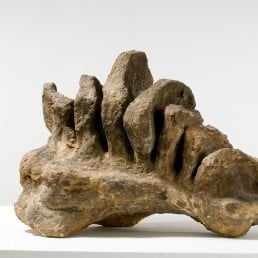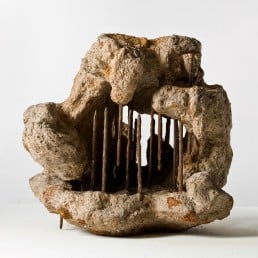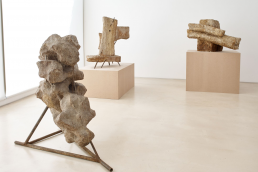
“Hers is a focused vocabulary, obsessively and repetitively fusing structure, mass and block (...) there is both certainty and uncertainty – and these modeled lumps and shapes carry the touch of the maker herself, as if emerging from the stroke and grasp of a cupped hand.” – Phyllida Barlow
In the countries that make up former Yugoslavia, Olga Jevrić is a name familiar to many – here, she is known as one of the most innovative artists of the 20th century. Yet despite her exceptionally unique abstract sculptures, her extensive research and work trips abroad, and her representation of Yugoslavia in the XXIX Venice Biennale in 1958, her works are rarely exhibited outside of Serbia and other countries in the region. The current exhibition “Olga Jevrić Sculpture” at London’s PEER Gallery finally brings her works to a British, and international, audience. The exhibition is Jevrić’s first solo show in London. “Olga Jevrić Sculpture”, which was co-curated by Fedja Klikovac of Handel Street Projects, is open till Saturday 14 September. Simultaneously, Handel Street Projects is also exhibiting works by Jevrić (28 June – 31 October).
Who was Olga Jevrić?
Olga Jevrić was born in Belgrade, Serbia in 1922. She studied both at the Academy of Music and at the Academy of Fine Arts in Belgrade. Initially, Jevrić created art in the realist tradition of the time, but by the mid 1950s, she began to move away from figuration and develop her own language of abstraction. Jevrić focused on sculptural abstraction, which at the time had no precedent in Yugoslavia. She preferred to refer to her pieces as “spatial compositions” rather than sculptures, clearly influenced by her musical training. Jevrić worked with a mixture of cement, iron dust, rods and nails in order to create distinct forms through which she investigated the relationship between solid matter and void, weight and weightlessness, and containment and release.



Olga Jevrić’s “Spatial Compositions”
Some of Olga Jevrić’s spatial compositions are small in scale, measuring less than 10 cm in height. At times these were created as models for larger sculptures for public memorials commemorating the struggles of the Yugoslav people during wartimes. These proposals for memorial monuments, however, were never realised, presumably because these non-associative abstractions were something completely new in the history of Serbian sculpture, and therefore not understood. Often, Jevrić worked in series – she would develop the same abstract configuration into works measuring around a metre in height and then make these even larger, as floor-standing works. The surface of her works have rough textures, creating the idea that they are not man-made, but rather created by nature. In her early works, she often forged her ideas from clay and then covered this in molten metal, usually iron. Later, she started mixing cement with iron dust, which she called “feroxide”. She produced her larger works in parts, first constructing a frame of wooden slats covered with wire mesh, and then pouring over the “feroxide” mixture. The whole was held together by iron rods.

“For Olga Jevric, the art which she was making and presenting represented the road she had chosen to walk on, mostly alone, without the support of the establishment, but without any doubt about the truth and the necessity of her mission.” – Dejan Vučetić
Themes and Inspirations
Jevrić witnessed the Second World War and its aftermath, and this had a profound influence on the themes of her artistic practice. She was interested in exploring the spiritual roots and cultural and social conditions of the war-torn environment in which she was developing her work. Additionally, she was inspired by the limestone carved medieval tombstones known as Stećci, which were scattered all across Yugoslavia. Jevrić has therefore said that she could not have created her work anywhere else but Serbia, and that her work was strongly bound to Belgrade.
Jevrić’s work also resonates with other post-war sculptural tendencies that connected with the prevailing human condition, such as with the British “geometry of fear” artists. This term was coined by the critic Herbert Read for a group of post-war British sculptors including Reg Butler, Kenneth Armitrage and Lynn Chadwick whose work was characterised by spiky, twisted forms.
According to Jevrić, her sculptures come from “the system of constructing based on dialectical structural principles”, and represent a leap from figurative sculptures of the body to spatial abstract sculptures. While Jevrić was using her preferred materials of concrete and iron, these materials were also giving shape to a new Yugoslavia, for example in the modernist concrete utopia of New Belgrade. Her spatial compositions, then, were boldly ushering in a new era without being fazed by the advent of loud, influential art movements such as pop art or the lack of support from the establishment. Instead, she continued to forge a body of work that not only had an important place in the development of abstract art, but which also came to represent the spiritual identity of the people of Yugoslavia.

Exhibitions at PEER Gallery and Handel Street Projects
Don’t miss your chance to experience Olga Jevrić’s extraordinary sculptures in person in London this fall. The independent arts organisation PEER, located in Hoxton in East London, presents the first ever retrospective of Olga Jevrić’s work in London. Simultaneously, Handel Street Projects in Islington, committed to promoting new British and international contemporary art, is exhibiting Jevrić’s spatial compositions. The retrospective at PEER Gallery runs through 14 September 2019, while the exhibition at Handel Street Projects has been extended till 31 October (by appointment only). All the sculptures at PEER Gallery come from three major collections in Belgrade: Heritage House, the Museum of Contemporary Art and the Serbian Academy of Sciences and Arts.
With thanks to Dejan Vučetić, curator at Heritage House Belgrade, for providing input for this article.
